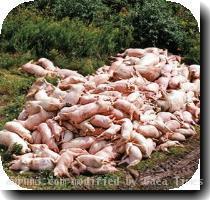Where’s the beef? Pork, bacon, ham _ despite ’swine’ flu fears, the edible pig is everywhere
By Ted Anthony, APFriday, October 30, 2009
Where’s the beef? In land of cowboys, pig thrives
The president of the National Pork Producers Council — the person who represents the people who represent the nation’s pigs — appeared recently before Congress to talk about sales in the swine flu era.
He wasn’t happy. “Things look bleak going forward,” Don Butler told America’s lawmakers.
Around the same time, the following events transpired:
— The usually beef-and-beany Taco Bell erected signs at the mouth of its drive-thru lanes, exhorting motorists around the republic: “TOP IT OFF WITH BACON.”
— Uncle Jack’s, one of New York City’s signature steakhouses, put out its sidewalk chalkboard of dinner specials. Getting top billing at the beef emporium, for $24,95, was not sirloin, not rib-eye, not filet mignon, but slow-roasted Berkshire pork shank.
— The brewmaster of Brooklyn Brewery, using an intricate process, crafted 25 experimental cases of — wait for it — bacon ale.
In this season of approaching winter holidays and abrupt spikes in ham consumption, this much is worth noting: In the land of the cowboy, the country where beef is held up as the meat that defines the American character, the pig in all its succulent, edible incarnations seems to be everywhere.
“As an interest in food, its origins and its preparation spreads around America, it makes sense that the American palate is widening past just burgers and steaks,” says Sasha Wizansky, the co-editor of Meatpaper, a magazine about meat culture in America.
“Practically every scrap of a pig can be transformed into something tasty,” she says, “and you can find a treasure trove of pork-centric dishes and cured products from around the world.” (Meatpaper’s first themed issue, earlier this year, focused on the hog.)
It’s not as if the pig suddenly arrived on the American scene. From the earliest settlements in Virginia, it’s one of the oldest domesticated creatures to make its way down American gullets. But somewhere along the line, pork was cast as an also-ran, below burgers and chicken in the culinary taxonomy.
Sure, ham and ribs and Southern barbecue were continuous staples for the American stomach. But for years, many Americans rarely ventured beyond the Shake ‘N Bake pork chop and its workaday suburban brethren. Even pork’s longtime slogan, “The Other White Meat,” suggested a status akin to how Avis approaches Hertz.
Is that changing? Ask Michael LaScola, chef and owner of American Seasons, a Nantucket, Mass., restaurant where you’ll find every part of the pig harvested into unusual recipes. Crispy pig ears, served up like French fries with a side of smoky ketchup? Check. Pig’s head bacon served with eggs sunny side up? Check. Pork-belly fritters with foie gras? Check. And check your cholesterol while you’re at it.
“Pork is definitely my favorite thing to play with and to cook with,” says LaScola, who recently co-hosted an event called, yes, Hogtoberfest.
“You can go sweet and you can go savory. And either way it works,” he says. “It has a lot of flavor but it’s not gamey like lamb would be. Or it doesn’t have that super blood iron kind of thing like some beef.”
And, as meats go, most cuts of pork remain quite affordable — no small matter when you’re trying to feed a family during a recession that’s pushing into its second year.
Then, of course, there’s bacon.
From Wendy’s Baconator sandwich to bacon-scented air fresheners and even bacon-flavored mints, the cured and smoked Porkbellicus Americanus has become something of a fetish object for carnivores and lipid lovers. It has reached the point where the words “chocolate-covered bacon” have become, for many, something appetizing.
You can buy “Baconnaise,” a condiment that has earned the good-natured scorn of Jon Stewart, and its companion product, Bacon Salt, which has been shipped to bacon-craving American troops serving in pork-free regions. You can even join the “Bacon of the Month Club,” perhaps the only subscription-based pork products service in the land. Or perhaps not.
“There are instances in which innovative bacon dishes work … and then there are times when you don’t really want bacon foam on your dessert or bacon fat in your latte,” Wizansky says. “In certain food circles, bacon saturation has become so extreme that chefs have completely abandoned it.”
Bacon seems to turn otherwise rational Americans into drooling, carnivorous maniacs. Consider food writer Joanna Pruess, rhapsodizing in the introduction of her book, “Seduced by Bacon”: “Bacon is far more than a food. It is a happy state of mind. It excites people to the point where some aficionados liken it to illicit pleasures. Can it be a religion?”
Odds are good that Joanna Pruess is neither Jewish nor Muslim.
Omaha Steaks, the mail-order company that does a brisk business in premium beef, has offered pork for many decades — including pork chops wrapped in, well, bacon — and is introducing thick-cut microwave bacon even as you read these words. Its senior vice president, Todd Simon, sees several reasons why pig products are capturing the imagination.
Pork, he proposes, not only gives the fast-increasing legions of American grillers “something new to throw into the flames” but also allows folks to dip their toes into the adventure of more unusual ethnic recipes while still holding onto the familiar and the traditional.
What’s more, Simon says, the culture of the whole pig as centerpiece to a very special meal holds a place in American culture that other whole animals don’t. “You never hear about a steer roast,” Simon quips.
All of this is not to say that Don Butler and the National Pork Producers Council don’t have legitimate worries. As they point out, pork producers have lost an average of $23 on each hog marketed during the past two years.
But in a land where Bacon Salt and Baconnaise are actually sustainable consumer products, where the landscape has more than 400 locations of a store called HoneyBaked Ham, surely the long-term prognosis for pork prosperity can’t be entirely bleak.
LaScola certainly doesn’t think so. And if you have any doubt, touch base with him next year. Whatever part of the pig he’s serving then, consider washing it down with a new drink he’s developing.
He calls it the BLT Bloody Mary.
EDITOR’S NOTE — Ted Anthony covers American culture for The Associated Press.
Tags: Chefs, Food And Drink, New York, New York City, North America, Restaurants, United States

